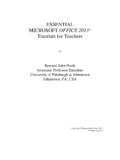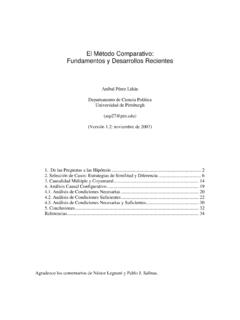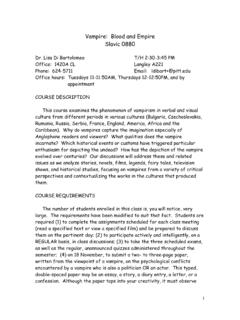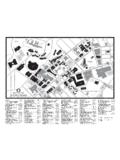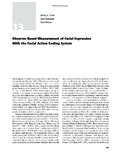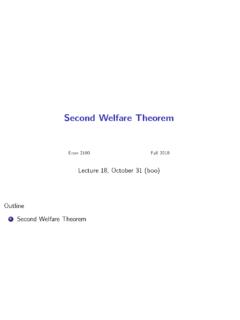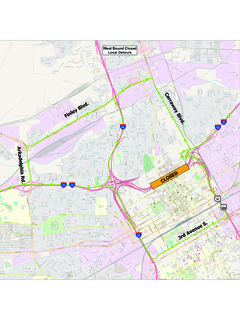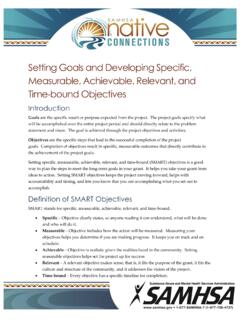Transcription of A Branch-and-Bound Framework for Unsupervised …
1 Noname manuscript No. (will be inserted by the editor). A Branch-and-Bound Framework for Unsupervised common Event discovery Wen-Sheng Chu1 Fernando De la Torre1 Jeffrey F. Cohn1,2 . Daniel S. Messinger3. Received: date / Accepted: date Abstract Event discovery aims to discover a temporal Video 1. segment of interest, such as human behavior, actions or activities. Most approaches to event discovery within or between time series use supervised learning. This Video 2. becomes problematic when some relevant event labels ]. ]. are unknown, are difficult to detect, or not all possi- ble combinations of events have been anticipated. To overcome these problems, this paper explores common Event discovery (CED), a new problem that aims to ] Kiss discover common events of variable-length segments in common an Unsupervised manner.
2 A potential solution to CED events is searching over all possible pairs of segments, which would incur a prohibitive quartic cost. In this paper, we propose an efficient Branch-and-Bound (B&B) frame- work that avoids exhaustive search while guaranteeing a globally optimal solution. To this end, we derive novel ] Handshake bounding functions for various commonality measures Temporal search space and provide extensions to multiple commonality dis- covery and accelerated search. The B&B Framework Fig. 1 An illustration of common Event discovery (CED). takes as input any multidimensional signal that can Given two videos, common events (kiss and handshake) of different lengths in the two videos are discovered in an unsu- be quantified into histograms.
3 A generalization of the pervised manner. Framework can be readily applied to discover events at the same or different times (synchrony and event com- monality, respectively). We consider extensions to video 1 Introduction search and supervised event detection. The effectiveness Event detection is a central topic in computer vision. of the B&B Framework is evaluated in motion capture of Most approaches to event detection use one or another deliberate behavior and in video of spontaneous facial form of supervised learning. Labeled video from experts behavior in diverse interpersonal contexts: interviews, or naive annotators is used as training data, classifiers small groups of young adults, and parent-infant face- are trained, and then used to detect individual occur- to-face interaction.
4 Rences or pre-defined combinations of occurrences in new video. While supervised learning has well-known advantages for event detection, limitations might be 1. Robotics Institute, Carnegie Mellon University, USA. noted. One, because accuracy scales with increases in 2. Department of Psychology, University of Pittsburgh, USA the number of subjects for whom annotated video is 3. Department of Psychology, University of Miami, USA available, sufficient numbers of training subjects are es- sential [12, 25]. With too few training subjects, super- 2 Wen-Sheng Chu et al. vised learning is under-powered. Two, unless an annota- ity metrics and compare discovery with expert annota- tion scheme is comprehensive, important events may go tions.
5 Our main contributions are: unlabeled, unlearned, and ultimately undetected. Three 1. A new CED problem: common Event Discov- and perhaps most important, discovery of similar or ery (CED) in video is a relatively unexplored prob- matching events is limited to combinations of actions lem in computer vision. Results indicate that CED. that have been specified in advance. Unanticipated events achieves moderate convergence with supervised ap- go unnoticed. To enable the discovery of novel recurring proaches, and is able to identify novel patterns both or matching events or patterns, Unsupervised discovery within and between time series. is a promising option. 2. A novel, Unsupervised B&B Framework : With To detect recurring combinations of actions with- its novel bounding functions, the proposed B&B.
6 Out pre-learned labels, this paper addresses common Framework is computationally efficient and entirely Event discovery (CED), a relatively unexplored prob- general. It takes any signals that can be quanti- lem that discovers common temporal events in variable- fied into histograms and with minor modifications length segments in an Unsupervised manner. The goal adapts readily to diverse applications. We consider of CED is to detect pairs of segments that retain maxi- four: common event discovery , synchronous event mum visual commonality. CED is fully Unsupervised , so discovery , video search, and supervised segment-based no prior knowledge about events is required. We need event detection. not know what the common events are, how many there A preliminary version of this work appeared as [13, are, or when they may begin and end.]
7 Fig. 1 illustrates 14]. In this paper, we integrate these two approaches the concept of CED for video. In an exhaustive search of with video search and supervised segment-based event variable-length video segments, kissing and handshake detection, and provide a principal way of deriving bound - event matches are discovered between videos. ing functions in the new, Unsupervised Framework . We also present new experiments on supervised event de- A naive approach to CED would be to use a slid- tection with comparisons to alternative methods. The ing window. That is, to exhaustively search all possi- rest of this paper is organized as follows. Sec. 2 dis- ble pairs of temporal segments and select pairs that cusses related work.
8 Sec. 3 presents the proposed B&B. have the highest similarities. Because the complexity of Framework for common event discovery . Sec. 4 applies sliding window methods is quartic with the length of the Framework to tasks of varying complexity. Sec. 5. video, , O(m2 n2 ) for two videos of lengths m and extends the B&B Framework to discovery among more n, this cost would be computationally prohibitive in than two videos and considers acceleration using warm- practice. Even in relatively short videos of 200 and 300 start strategy and parallelism. Sec. 6 provides evalua- frames, there would be in excess of three billion possible tion on Unsupervised and supervised tasks with unsyn- matches to evaluate at different lengths and locations.
9 Chronous and synchronous videos. Sec. 7 concludes the To meet the computational challenge, we propose paper with future work. to extend the Branch-and-Bound (B&B) method for CED. For supervised learning, B&B has proven an effi- 2 Related Work cient technique to detect image patches [35] and video volumes [77]. Because previous bounding functions of This paper is closely related to event detection meth- B&B are designed for supervised detection or classifi- ods, and Unsupervised discovery in images and videos. cation, which require pre-trained models, previous B&B Below we review each in turn. methods could not be directly applied to CED. For this reason, we derive novel bounding functions for various Event detection commonality measures, including `1 /`2 distance, inter- CED closely relates to event detection.
10 Below we cat- section kernel, 2 distance, cosine similarity, symmeter- egorize prior art into supervised and Unsupervised ap- ized cross entropy, and symmeterized KL-divergence. proaches, and discuss each in turn. For evaluation, we apply the proposed B&B to ap- Supervised event detection: Supervised event plication of discovering events at the same or different detection is well-developed in computer vision. events times (synchrony and event commonality, respectively), can be defined as temporal segments that involve ei- and variable-length segment-based event detection. We ther a single pattern of interest or an interaction be- conduct the experiments on three datasets of increasing tween multiple patterns. For single-pattern event detec- complexity: Posed motion capture and unposed, spon- tion, popular examples include facial expression recog- taneous video of mothers and their infants and of young nition [19, 38, 42, 59, 69], surveillance system [22], activ- adults in small groups.
